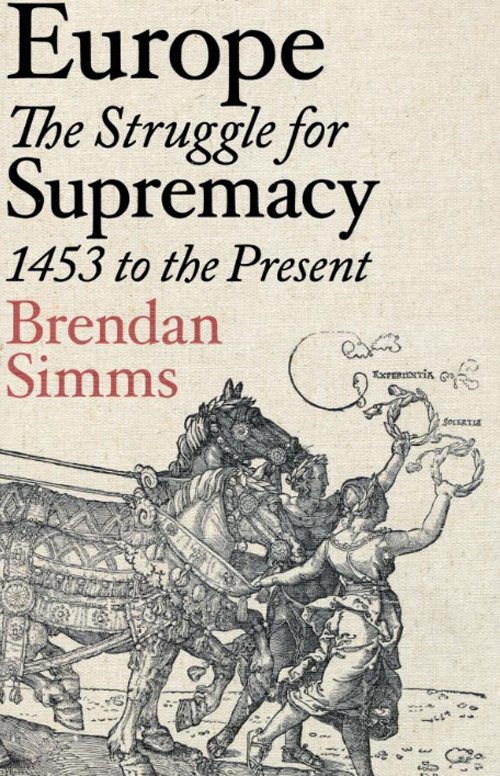Europe: The Struggle for Supremacy, 1453 to the Present
Review

Brendan Simms, Europe: The Struggle for Supremacy, 1453 to the Present (Allen Lane, 2013), pp. 690
This book returns to territory which Simms' first explored in The Struggle for Mastery in Germany, 1779 - 1890. Like its predecessor, it owes much to the tradition of international history advanced by the likes of A J P Taylor. Indeed, the titles of Simms' books on this subject consciously echo Taylor's iconic The Struggle for Mastery in Europe.
A book about the rivalries between great powers, Simms' narrative is informed by two principles. The first is that foreign policy is the irreducible, indispensable context for the writing of history. States exist and compete with one another within a system, and said competition is the force which is primarily (if not wholly) responsible for the political, moral, philosophical, legal (etc, etc.) development of those polities. The second principle which Simms' advances throughout his narrative is that, within the European state system, the most important area has historically always been ‘Germany' (loosely defined), and that control of the same has been the single most important geopolitical concern of most, if not all, of the major European powers.
By ‘Germany', of course, Simms' really means the German speaking lands of the European interior and the various states which have, from time to time, occupied that area. According to his analysis, these German lands have traditionally interacted with the rest of Europe in one of two ways: passively from c. 1453 - c. 1860, and actively thereafter. Prior to the 1860s, the German area (in the form of the Holy Roman Empire) lacked the cohesiveness to function effectively as a single unit on the international stage. The plurality of authorities within it - local, regional, ecclesiastical (Catholic and Protestant) and secular - gave rise to internal divisions and incessant intervention by foreign powers. After the demise of the Empire, Simms argues that the rise of German nation states - such as Austria-Hungary and, of course, Germany itself - unleashed the latent demographic and material potential of the area and (in the context of a continent wide arms race and quest for Imperial status) set it on a collision course with its neighbours. During the first and second World Wars this conflict was primarily militaristic. During the Cold War, Germany assumed a central position in European (indeed, global) affairs as the strategic hub and ideological showcase of the Eastern and Western blocs. After the re-unification of Germany and its entry into the Common Market, Simms argues that the aforementioned material and demographic resources were once again channelled to achieve European hegemony - only this time in the (far more palatable) form of economic, rather than militaristic imperialism.
Simms' argument has several interesting features - most notably a persuasive analysis of the manner in which the USA continued to conceptualise its national security in European terms. These features are overshadowed, however, by the issues which his general thesis presents. In the first instance, many historians will without doubt have serious difficulty with the contention that foreign policy is the context for academic enquiry into the past. Pure diplomatic history has been out of fashion for almost a century; generally because it is considered too narrow and prescriptive an approach. Allied to this objection is Simms' equally dubious assumption that the internal development of a state runs entirely in parallel with its fundamental international ambitions (itself predicated upon the idea that these ambitions have not substantially altered in the past five hundred years). Secondly, it is notable that German centrality is justified both in terms of national passivity and aggression. In other words, ‘Germany' is important precisely because it has been both victim and aggressor. But what nation or state has ever been otherwise? Certainly, Germany has more immediate neighbours than any other European country and this naturally would make it subject to a fear of encirclement, but in that case why not focus primarily on the role of the aggressors - notably France? Indeed, it is not entirely clear why fear of encirclement should be presented as an almost uniquely German concern, since France also laboured under a similar predicament; caught between the Holy Roman Empire in the East and the Hapsburg territories of Spain and the Netherlands in the South and North. In which case, an analysis of European instability might be better of focusing on this shared fear, and the mutual antagonism which it bred in both states. Thirdly, in developing his argument Simms' makes some extremely unorthodox assertions about the ‘real' reasons for certain historic events and developments. For example, he entirely glosses over the domestic context of the English Civil Wars (and Scottish Bishops' Wars) in his explanation of the deposition of Charles I. He also asserts that a banking crash in Germany (precipitated by the French) was the real cause of the global recession of the early twentieth century, rather than events on Wall Street. These are by no means the only examples. Moreover, he offers very little in the way of supporting evidence, analysis, explanation or discussion of these judgements.
To conclude, this is a purposeful book with a clear contemporary resonance. Anyone with an interest in the current intellectual and political debate over the future of the ‘European project', not least the single currency, should be intrigued by this attempt to contextualise European multilateralism. Simms' contention that Europe has long marched to the ‘German' tune is certainly provocative, but it is not ultimately convincing. What the argument does demonstrate, perhaps above all, is the difficulty inherent in truly encompassing the scope and complexity of such a huge period within the confines of a single-issue narrative.

